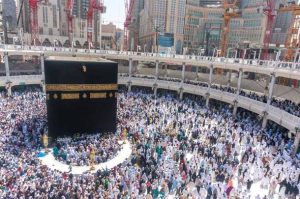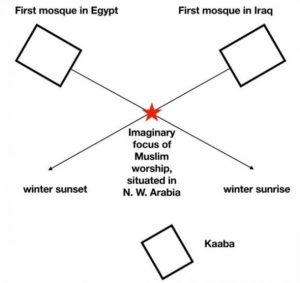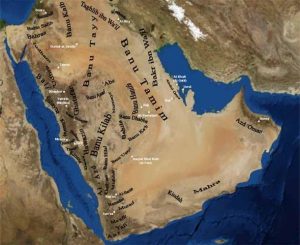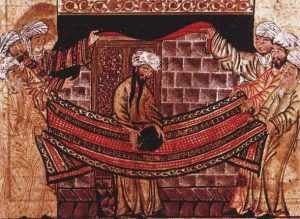What Is Mecca’s Actual Location?

Most people will recognize Mecca as the name for the Holy City of Islam. Do you know where the Holy City is? Do you know where it should be? Did it get lost? Was it ever found? Believe it or not, there will be disagreements about the answers to those questions. It seems like the fan is running, and the various responses to questions about the location of Mecca sometimes make quite a mess. Some people will denounce the answers as blasphemous, and other people will make cases for the egregious lack of intellectual and historical integrity in the answers.

The location of Mecca has long been in Saudi Arabia but was it always there? (mawardi bahar/EyeEm/Adobe Stock)
What In The World Is Mecca?
Makkah al-Mukarramah is the official name for Mecca. Makkah is the official Saudi transliteration and comes closer to the Arabic pronunciation. Mecca is 70 kilometers (43.5 miles) east of the Red Sea in the Mecca province within the Hejaz region of Saudi Arabia. But that’s not the end of the story.
Mecca is thought to be the site of a spring or a well that God miraculously created as His angel ministered to Hagar and Ishmael after they were banished and at death’s door from wandering the desert for days.
Mecca is the birth home of Islam’s Prophet Muhammad. Moreover, Muhammad says Mecca is where Allah revealed the Koran to him.
The Black Stone further venerates Mecca. The story is that it was sent down with Adam after ‘the Fall’ to show him where to build a temple. Today, the Black Stone is set in the eastern corner of the Ka’aba, a cube-shaped granite building in the center of the Masjid Al-Haram in Mecca, the largest and holiest mosque in the world.
If they are physically and financially able, Muslims worldwide are obligated to make a pilgrimage or Hajj to Mecca and the Ka’aba at least once in their lives. In addition, Muslims the world over direct their focus during daily prayers in the direction of the Masjid Al-Haram.

The location of Mecca very much relates to the original location of the Black Stone, which is a fragmented assembly of the “original” big black rock broken into pieces. The fragmented Black Stone as it appeared in the 1850s, front and side illustrations. (Public domain)
Was Mecca Here One Day And Somewhere Else The Next?
That is a simple question. Nobody thinks Mecca has been barhopping across the Middle East or even across an ocean to Harlem. The actual question is whether the Masjid Al-Haram has always been in Mecca or if it had a different location in antiquity.
Let’s start with the Black Stone. Its story says it has been around since the Fall of Adam and Eve. As instructed by Allah, its location was the site of the first Masjid Al-Haram. Mecca is the right location for the Masjid Al-Haram because the Black Stone is there. Right?
Archaeology Speaks!
It sounds good except for one thing. Jerusalem has been around for a decent amount of time. It was a settlement around the 3rd millennium BC, and the first historical mention was in the 2nd millennium BC. Archeological digs have unearthed a massive amount of ancient relics around modern Jerusalem.
If we are to believe the history Islam advocates, then Ishmael and Abraham built the Ka’aba to house the Black Stone. So, the first placement past Adam and Eve, in the beginning, was Abraham during the 2nd millennium BC when they erected the Ka’aba in the Masjid Al-Haram. However, the idea of Mecca being this place stands on nothing. Archaeology cannot locate similar 2nd millennium BC artifacts around Mecca as it has around Jerusalem. If Mecca was such a holy place, making it a popular tourist spot even in 2,000 BC, wouldn’t there be a few relics buried in the dust from those by-gone days?
The Old Mosques Speak Too!
Dan Gibson is a rather outspoken proponent of the idea that the current location of the Masjid Al-Haram in Mecca is not the same as the original location of the Masjid Al-Haram. He starts from the premise that Islamic mosques would have been built facing Masjid Al-Haram. He claims to have examined the first Islamic mosques and discovered that lines drawn in the direction each of them faces intersect at the location of the ancient city of Petra. How much more compelling can it be than to get the shrines of Islam to invalidate the site of its Holy City?

The earliest mosques of both Iran and Egypt faced east but seem to be aligned to a location further north of present-day Mecca as this diagram shows. Virtually all Islamic scholars dispute this by claiming Mecca’s precise location was not so easy to find for early Muslim mosque architects, and they used astronomical horizon phenomena, namely, winter sunrise in Egypt and winter sunset in Iraq (Muslim Heritage)
Are There More Witnesses With Testimony?
It is not debatable that the Black Stone hasn’t stayed right where it is now since Adam’s fall. The Karamathians removed the Black Stone in 980 AD and carried it away to their territory in the Arabian Gulf. They possessed the Black Stone for twenty years and returned it to Mecca in 1002 AD. This was not the only time the Black Stone was relocated. It seems to have been stolen several times throughout history, but it has always somehow managed to end back up in the Ka’aba.
If the story of Hagar and Ishmael being saved by an angel at Mecca is true, then a person would have to believe that Hagar managed to traverse 1,000 miles of desert to get to Mecca from the Holy Land, and then she did it all over again to return – and with a little kid! Putting her at Petra is quite a bit more believable. Then, there is the idea that Abraham and Ishmael built the Ka’aba. Judeo-Christian scriptures confirmed by the archaeological record refute the idea that Abraham ever went anywhere within 1,000 miles of Mecca.
The Quran speaks of Mecca and describes it as a city on a major trade route surrounded by rice fields, fig-trees, olive trees, and vineyards. It is Umm al-Qura, or “Mother of all cities.” It is spoken of as an oasis for caravans on a major trade route. In Mohammad’s time, the present location of Mecca would not have been an oasis. It would have been unimpressive except for its amount of pagan worship, dust, and heat. Besides, it was not close to any central trade route.
Finally, there is a lack of mention of Mecca in the historical record before the rise of Islam. Muhammad was born in Mecca in 570 AD. However, the first mention of Mecca didn’t happen until 741 AD in the Byzantine-Arab Chronicle, and it says it’s located in Mesopotamia rather than the Hejaz.

The Mecca region and the primary tribes of Saudi Arabia at the dawn of Islam, showing an overwhelming concentration in the area around Mecca. (Slackerlawstudent / Public domain)
1,000 Words Painted A Dubious Picture Of Mecca
So far, only the tip of the iceberg has been touched by a few reasons why the Holy City of the Quran can’t possibly be in Mecca. There are many other ideas about why Mecca isn’t the original Holy City. If the quantity of arguments against Mecca makes a difference, don’t make any real estate investments in the area.
Now, Tell Me What’s On The Other Side Of The Coin
Sometimes, how you see something depends on where you stand. The historical record may be silent about Mecca, but the absence of any mention shouldn’t be taken as positive proof that Mecca was never the Holy City. At best, silence is merely circumstantial.
Artifacts discovered around Jerusalem are irrelevant to Mecca. A person might say, “There haven’t been any ancient artifacts discovered around Mecca. So what?”
As far as the Black Stone is concerned, the first comment made here still stands unrefuted. While the Black Stone may have been stolen and absent from Mecca during several periods of history, it always made its way back to the Ka’aba, where it is currently displayed.
Why should Hagar’s trip through the desert to Mecca be outlandish? One thousand miles of desert is a sobering thought, but so is the idea of the Jewish people wandering through a desert for 40 years until they reach the Promised Land.
We move to the next point. The Quran speaks highly of Mecca. It seems to take a picture of Mecca today and then exaggerates and distorts it. That is not an unusual literary device. Exaggeration is often used to demonstrate some aspect of something. In this case, the beauty and importance of Mecca are exaggerated. Criticism of the technique begs an answer: “So…?”

The Islamic prophet Muhammad solves a dispute over lifting the black stone into position at the al-Kaaba, Mecca, Saudi Arabia. In the center, Prophet Muhammad, with two long hair plaits, places the stone on a carpet held at the four corners by representatives of the four tribes, so that all have the honor of lifting it. (Rashid Al-Din / Public domain)
Here Come The Big Guns…
One of the stories in the Quran has Muhammad destroying 360 pagan idols showcased on the Ka’aba. It would be unlikely for that story to have happened in Petra. At the time of this story, Petra was firmly under the control of the Byzantine Empire. Byzantine culture and religion prohibited the type of pagan worship said to have happened in Mecca. The story is best suited for Mecca.
The orientation of the early mosques away from Mecca and towards Jerusalem, Petra, or somewhere else is often the main focus of those who want to dispute Mecca as the Holy City. Some of the earliest mosques would likely have faced Jerusalem, as was the practice before Muhammad. While Muhammad was born in 570 AD, the oldest copy of the Quran discovered dates back to 670 AD.
Several things can be noted as far as the intersection of lines extending outward from the direction the mosques were facing. Some mosques faced Jerusalem. Some mosques faced Petra. Some mosques faced Mecca. Some mosques didn’t point anywhere near any of those three places. So, what’s up with that?
The mathematic formulas detailing another argument are too complicated to go into here. There is the possibility that the mosques were built according to astronomical orientation. The explanation is offered as a generality. Another explanation is one based on plate tectonics. In other words, the Earth has shifted since the mosques were built.
Another explanation says we should give the early Muslims a break. They did the best they could to orient things toward the Ka’aba. Not understanding how a round Earth affects straight lines on a flat surface could account for errors.
The strongest argument comes from the Islamic tradition of praying in the direction of the Ka’aba and how the ordinary person should think of the law they face while praying.
Imans have said the direction of prayer is an easy thing to determine. Anywhere between east and west is acceptable. So, according to that standard, it would seem that the mosques comply by facing somewhere in the neighborhood of Mecca. If Islamic leaders are no more concerned with exact directions, why would it be appropriate for anyone outside of Islam to impose stricter requirements?
What Does Science Have To Do With Any Of This?
Is the attempt to use science to substantiate or dispute any religion’s stories, practices, or principles proper? When we consider the foundations of science and religion, we find they are built on different materials.
Science is based on knowing. Religion is based on believing. Knowledge and faith occupy two separate spheres. It would be ludicrous to validate E=Mc 2 based on believing it is true. Likewise, it is as preposterous to suggest that Muslim tradition is somehow debunked by suggesting no Muslim ever knows precisely in what direction the Ka’aba is standing.